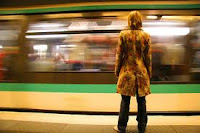Shutter Speeds (write out the speeds and explain what they mean)- 1/1000 s, 1/500 s, 1/250 s, 1/125 s, 1/60 s, 1/30 s, 1/15s, 1/8 s, 1/4 s, 1/2 s, 1 s.
Shutter Priority- Shutter priority refers to a setting on some cameras that allows the user to choose a specific shutter speed while the camera adjusts the aperture to ensure correct exposure.
Exposure & how to set your camera for a good exposure- Exposure is the total amount of light allowed to fall on the photographic medium (photographic film or image sensor) during the process of taking a photograph. There are two components of exposure: brightness and duration.
Your camera’s metering system thinks of everything as 18% gray. The "Zone System: can be very helpful in getting a good exposure on a digital camera. If you want your camera to make exposure decisions for you, then you can use matrix metering.
Bulb- It is a shutter speed setting on an adjustable camera that allows for long exposure times under the direct control of the photographer. The shutter simply stays open as long as the shutter release button remains depressed.
Cable Release-The are the mechanisms attached to cameras that allow photographers to snap photos from a distance. The are generally attached to a camera atop a tripod, a cable release consists of a wire, extending from the camera, that has a button trigger at the end of it. The photographer holds the button end of the cable and presses to trigger the camera shutter to take a photo.
Tripod- It is used to stabilize and elevate a camera, or to support flashes or other photographic equipment.
Light Meter- Device used to measure the amount of light. It is often used to determine the proper exposure for a photograph.
Bracketing- It is the general technique of taking several shots of the same subject using different or the same camera settings. It is useful and often recommended in situations that make it difficult to obtain a satisfactory image with a single shot, especially when a small variation in exposure parameters has a comparatively large effect on the resulting image.
Hot Shoe- It is a mounting point on the top of a camera to attach a flash unit.
-----------------------------------------------------------------------------------------------------------
SLOW SHUTTER SPEED- (8-30)
PANNING- (60-250)
PAINTING WITH LIGHT- (1[?])
MULTIPLE EXPOSURES- (125)
FAST SHUTTER SPEED - (1000)














